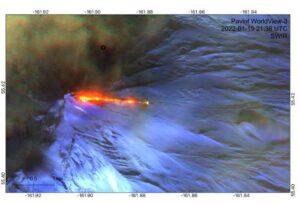
Lava erupts at Pavlof Volcano on Jan. 19, 2022. This shortwave infrared false color image shows the lava flowing from the volcano’s eastern flank and extending almost a mile eastward.
A new automated system of monitoring and classifying persistent vibrations at active volcanoes can eliminate the hours of manual effort needed to document them.
Graduate student researcher Darren Tan at the University of Alaska Fairbanks Geophysical Institute led development of the system, which is based on machine learning. Machine learning is a branch of artificial intelligence focused on building systems that learn from data, identify patterns and make decisions with minimal human intervention.
Details about Tan’s automated system were published June 11 in the journal JGR Solid Earth.
His system documents volcanic tremor, a continuous, rhythmic seismic signal that emanates from a volcano. It often indicates underground movement of magma or gas and occurs regularly at active volcanoes.
Knowledge of volcanic tremor can help in forecasting and detecting eruptions.
Unlike volcanic earthquakes, volcanic tremor is a sustained ground rumble that can last from a few seconds to a year or more. It is primarily identified in spectrograms because of its varying intensity and frequency.
“Volcanic tremor isn’t typically detected or cataloged, because it tends to be quite subtle in the seismic data,” Tan said. “It doesn’t have the impulsive onset like an earthquake does.”
Detecting tremor is currently a manual process at the Alaska Volcano Observatory, with which Tan is also affiliated. The observatory is a joint program of the Geophysical Institute, the Alaska Division of Geological and Geophysical Surveys and the U.S. Geological Survey. Part of the observatory is based at the Geophysical Institute.
The observatory’s daily duty seismologist scans spectrograms at 32 volcano-monitoring networks across Alaska, looking for the slight indications of tremor in addition to the obvious seismic signals.
“The duty seismologists go in every day, and sometimes twice a day or more depending on the volcanic activity, to look at spectrograms,” Tan said. “They look from volcano to volcano, hour to hour, and it takes a long time.”
Alaska has 54 volcanoes classified as “historically active,” meaning they have erupted in the past approximately 300 years. Of those, 32 have seismic monitoring networks.
Tan drew upon the diversity of tremor signals from the 2021-2022 eruption of Pavlof Volcano, on the Alaska Peninsula, to build an extensive dataset of labeled seismic and low-frequency acoustic spectrograms. Those spectrograms represent a variety of classifications, such as tremor type, explosions and earthquakes, that were then used to train a computer model for each data type.
The trained models can detect and classify volcanic tremor in near real time. Humans will still be involved in interpreting what the automation produces, however.
“To be able to place our focus on time periods of interest, that is key,” Tan said. “I think that reinvents the way we can monitor long-duration eruptions, because things can get missed when a volcano is active for a year and a half or two years.”
“This automated method of detecting tremor is also an important contribution to the forecasting and detection of eruptions,” he said.
Tan said machine learning is a rapidly growing field with great possibilities.
“It’s like the Wild West of machine learning right now,” he said. “Everyone is trying to dip their toes into this, but it is important to do so carefully.”
UAF researchers among the seven co-authors of the journal paper include David Fee, Alaska Volcano Observatory coordinating scientist at the Geophysical Institute; Társilo Girona, Geophysical Institute research assistant professor; and research assistant professor Taryn Lopez, also of the Geophysical Institute.
Matthew Haney, Chris Waythomas and Aaron Wech at the USGS and former UAF postdoctoral researcher Alex Witsil, now at Applied Research Associates in North Carolina, are also co-authors.
The research was funded by the National Science Foundation’s Prediction of and Resilience against Extreme Events eruption forecasting project and the Alaska Volcano Observatory.
